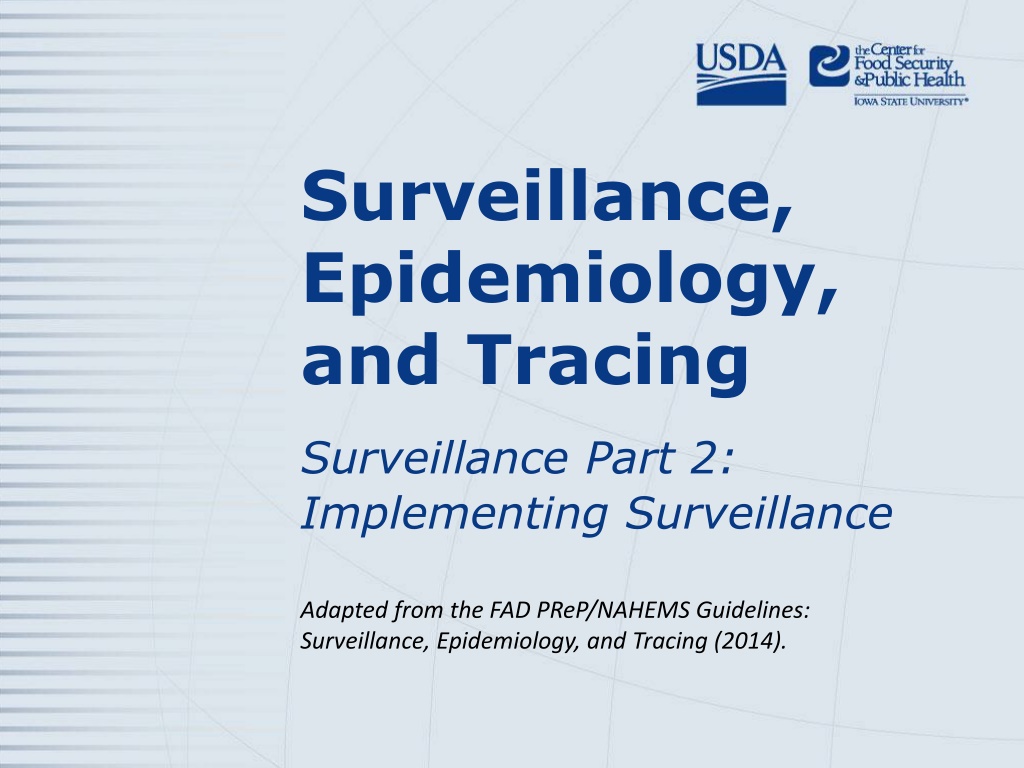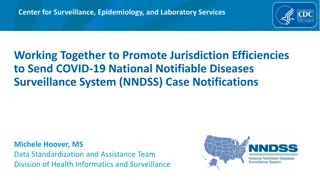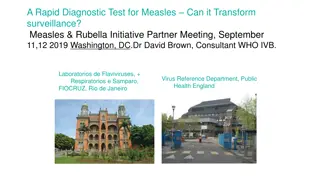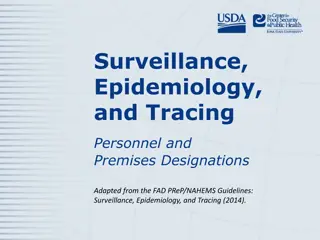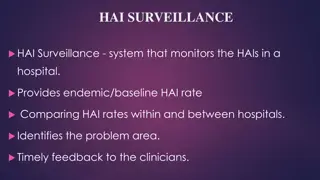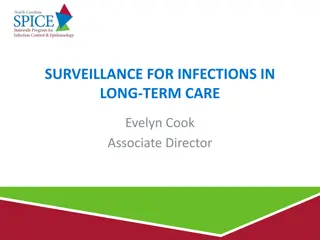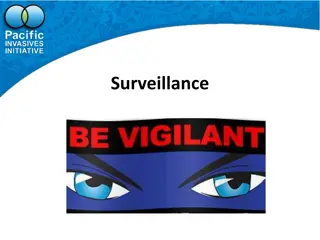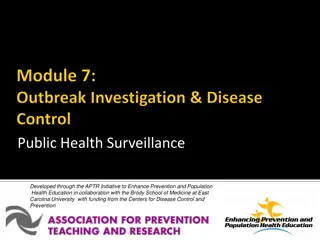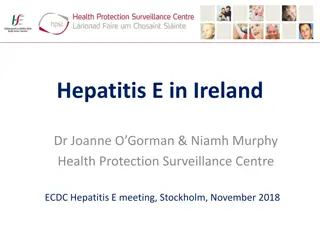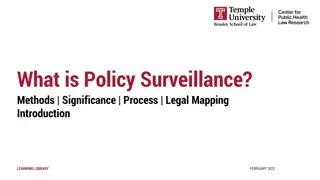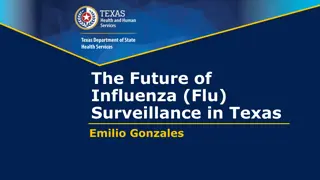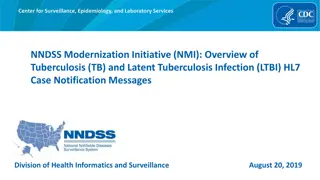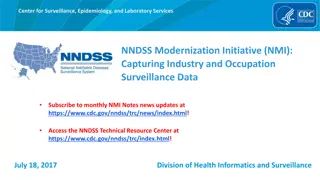Implementing Surveillance in Epidemiology: Methods and Considerations
This presentation outlines sampling methods and considerations for implementing surveillance in epidemiology. It covers aspects such as sample types, sizes, random vs targeted sampling, and the comparison between the two approaches. The content provides insights into the practical aspects of surveillance planning and resource utilization based on FAD PReP/NAHEMS guidelines.
Download Presentation

Please find below an Image/Link to download the presentation.
The content on the website is provided AS IS for your information and personal use only. It may not be sold, licensed, or shared on other websites without obtaining consent from the author. Download presentation by click this link. If you encounter any issues during the download, it is possible that the publisher has removed the file from their server.
E N D
Presentation Transcript
Surveillance, Epidemiology, and Tracing Surveillance Part 2: Implementing Surveillance Adapted from the FAD PReP/NAHEMS Guidelines: Surveillance, Epidemiology, and Tracing (2014).
This Presentation Describes sampling methods Outlines diagnostic tests Diagnostic sample collection Overview of surveillance planning resources FAD PReP/NAHEMS Guidelines: Surveillance, Epi, and Tracing - Surveillance Part 2 USDA APHIS and CFSPH
Sampling Methods FAD PReP/NAHEMS Guidelines: Surveillance, Epi, and Tracing - Surveillance Part 2 USDA APHIS and CFSPH
Sampling Methods Considerations for accurate and practical sampling methods: Sample type Sample size Random sampling vs. targeted sampling Sampling duration and frequency Sample areas/locations Availability of diagnostic tests Pooled testing FAD PReP/NAHEMS Guidelines: Surveillance, Epi, and Tracing - Surveillance Part 2 USDA APHIS and CFSPH
Sample Type and Size Sample type Disease agent Available tests Laboratory capabilities Sample size Population size Disease prevalence Diagnostic test sensitivity Confidence level FAD PReP/NAHEMS Guidelines: Surveillance, Epi, and Tracing - Surveillance Part 2 USDA APHIS and CFSPH
Random vs. Targeted Random sampling Every animal in the targeted population has an equal chance of getting selected for testing Targeted sampling May choose animals for convenience or because a certain group has a specific risk factor or higher prevalence of disease FAD PReP/NAHEMS Guidelines: Surveillance, Epi, and Tracing - Surveillance Part 2 USDA APHIS and CFSPH
Comparison Random sampling Every animal has an equal chance of being selected for testing Preferred over non- random sampling for determining prevalence or incidence of disease Results are better extrapolated Targeted sampling Animals not chosen randomly Usually preferred during a disease outbreak Primary objective is to identify cases of disease Cost effective and increases likelihood of finding new cases FAD PReP/NAHEMS Guidelines: Surveillance, Epi, and Tracing - Surveillance Part 2 USDA APHIS and CFSPH
Sampling Frequency Surveillance Begins as soon as possible in an FAD outbreak Susceptible animals Sampled a minimum of three times during the maximum incubation period FAD PReP/NAHEMS Guidelines: Surveillance, Epi, and Tracing - Surveillance Part 2 USDA APHIS and CFSPH
Determining Frequency Latent period Period of time between host infection and ability to infect others Incubation Period Period of time between infection and development of clinical signs Infectious period Period of time that an infected animal can transmit the pathogen to another susceptible animal Rapidity of disease transmission Likelihood of disease spread FAD PReP/NAHEMS Guidelines: Surveillance, Epi, and Tracing - Surveillance Part 2 USDA APHIS and CFSPH
Sampling Areas/Locations Target population may be selected based on area or location FAD PReP/NAHEMS Guidelines: Surveillance, Epi, and Tracing - Surveillance Part 2 USDA APHIS and CFSPH
Other Considerations Diagnostic test availability Validated and approved Affected by manufacturer capacity, reagent availability, etc. Pooled testing Samples from multiple animals are combined into a single test Cost effective and useful when resources are limited May not be appropriate for all samples FAD PReP/NAHEMS Guidelines: Surveillance, Epi, and Tracing - Surveillance Part 2 USDA APHIS and CFSPH
Diagnostic Tests FAD PReP/NAHEMS Guidelines: Surveillance, Epi, and Tracing - Surveillance Part 2 USDA APHIS and CFSPH
Choosing a Diagnostic Test National Veterinary Services Laboratory (NVSL) determines which diagnostic tests will be used Factors considered include: Speed Reliability and reproducibility Precision and accuracy Ease of use Cost FAD PReP/NAHEMS Guidelines: Surveillance, Epi, and Tracing - Surveillance Part 2 USDA APHIS and CFSPH
Sensitivity and Specificity Sensitivity Ability of a test to correctly classify diseased animals as positive Specificity Ability of test to correctly classify non-diseased animals as disease negative FAD PReP/NAHEMS Guidelines: Surveillance, Epi, and Tracing - Surveillance Part 2 USDA APHIS and CFSPH
Laboratory Capacity Foreign Animal Disease Diagnostic Laboratory (FADDL) Plum Island, NY National Veterinary Services Laboratories (NVSL) Ames, IA National Animal Health Laboratory Network (NAHLN) Various approved laboratories FAD PReP/NAHEMS Guidelines: Surveillance, Epi, and Tracing - Surveillance Part 2 USDA APHIS and CFSPH
Diagnostic Sample Collection FAD PReP/NAHEMS Guidelines: Surveillance, Epi, and Tracing - Surveillance Part 2 USDA APHIS and CFSPH
Types of Specimens Blood or serum Skin or vesicular lesions Epithelial tissue or vesicular fluid Feces, rectal swabs, cloacal swabs, or genital tract swabs Semen samples Nasal, oral, or oropharyngeal swabs Nasal discharge, saliva, tears Tissues Tonsil, spleen, kidney, liver, lymph node, lung, brain, etc. Milk Other environmental samples FAD PReP/NAHEMS Guidelines: Surveillance, Epi, and Tracing - Surveillance Part 2 USDA APHIS and CFSPH
Specimen Collection Follow protocols to prevent cross- contamination and sample degradation Collecting specimens Packaging specimens Biosecurity protocols FAD PReP/NAHEMS Guidelines: Surveillance, Epi, and Tracing - Surveillance Part 2 USDA APHIS and CFSPH
Freedom from Infection Demonstrating freedom from infection is part of a surveillance plan Freedom from infection Implies the absence of the pathogen in a country, zone or compartment Must be demonstrated to the World Organization for Animal Health (OIE) Standards outlined in Chapter 1.4 of the OIE Terrestrial Animal Health Code FAD PReP/NAHEMS Guidelines: Surveillance, Epi, and Tracing - Surveillance Part 2 USDA APHIS and CFSPH
Surveillance Planning Resources FAD PReP/NAHEMS Guidelines: Surveillance, Epi, and Tracing - Surveillance Part 2 USDA APHIS and CFSPH
Planning Resources Outbreak Surveillance Toolbox Assists in surveillance plan development Provides: Case definitions and case classifications Premises classifications Disease control zones Sampling plans FAD PReP/NAHEMS Guidelines: Surveillance, Epi, and Tracing - Surveillance Part 2 USDA APHIS and CFSPH
For More Information FAD PReP/NAHEMS Guidelines: Surveillance, Epidemiology, and Tracing, and SOP: Surveillance http://www.aphis.usda.gov/fadprep Surveillance, Epidemiology, and Tracing web-based training module http://naherc.sws.iastate.edu/ FAD PReP/NAHEMS Guidelines: Surveillance, Epi, and Tracing - Surveillance Part 2 USDA APHIS and CFSPH
Guidelines Content Authors (CFSPH) Kerry Leedom Larson, DVM, MPH, PhD, DACVPM Glenda Dvorak, DVM, MPH, DACVPM Janice Mogan, DVM Courtney Blake, BA Reviewers (USDA APHIS VS) Dr. R. Alex Thompson Dr. Lowell Anderson Dr. Steve Goff Dr. Fred Bourgeois FAD PReP/NAHEMS Guidelines: Surveillance, Epi, and Tracing - Surveillance Part 2 USDA APHIS and CFSPH
Acknowledgments Development of this presentation was by the Center for Food Security and Public Health at Iowa State University through funding from the USDA APHIS Veterinary Services PPT Authors: Patricia Futoma, Veterinary Student; Kerry Leedom Larson, DVM, MPH, PhD, DACVPM Reviewers: Janice Mogan, DVM; Melissa Lang, BS
